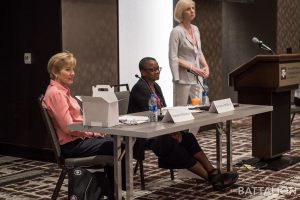Aggie alumni discuss diversity in the newsroom at Friday panel

Charean Williams, Class of 1986, and Kathleen McElroy, Class of 1982, spoke to students, teachers and other attendees at Friday’s seminar on diversity in journalism. Photo by Annie Lui
Students, teachers, journalists and speakers gathered in the Century Ballroom of the Texas A&M Hotel & Conference Center to discuss a pressing topic in the media world today — diversity.
The estimated 180 participants, including high school students from around the area, exchanged conversation and questions concerning the actions to take regarding diversity and the importance of this multidimensional coverage.
The event, held March 22, featured a group of Aggie graduates who have made a name for themselves in today’s journalism world — Kathleen McElroy, Class of 1982; Charlean Williams, Class of 1986; Sonia Moghe, Class of 2007; and Chevall Pryce, Class of 2017.
J. Kevin Barge, head of the Department of Communication, started the discussion by addressing the current news climate and shortcomings of the media to this point.
“The staffing of the American news media has never fully reflected diversity of the nation,” Barge said. “For most of the country’s history, Latino and non-white journalist were not welcomed in most newsrooms, and created their own outlets to cover information the white press was ignoring.”
Barge said the numbers show that despite diversity being a stated priority for many years, the journalism industry has a long way to go.
“The American Society of Newsroom Editors in 1978, stated [the goal was] to bring newsroom diversity numbers to parity, however, the national averages have not materialized despite the large demographic shift,” Barge said. “In 2017, Latinos represented 17 percent of the makeup in the newsroom, despite holding nearly 38 percent of the population. Women hold 51 percent of the population, but only hold 38 percent of media jobs within the industry.”
The discussion followed with keynote speaker Kathleen McElroy, who worked for The New York Times and now is the director of the School of Journalism at the University of Texas at Austin. McElroy addressed the dangers that a lack of diversity creates for the public.
“Diversity in the newsroom is absolutely critical,” McElroy said. “When speaking of diversity, we are talking about being multidimensional. Being multidimensional means having a voice for every individual within our country.”
McElroy said diversity in a newsroom is a necessity to achieve accurate, high-quality news.
“A smart newsroom is going to have all types of voices,” McElroy said. “Being multidimensional means granting people who are counted but not heard, a voice.”
Diversity is often associated strictly with ethnicity. However, CNN Breaking News and Digital Storytelling Producer Sonia Moghe said that diversity encompasses a much broader range of characteristics than racial background alone.
“Diversity to me means people’s different perspectives. That can be race, socio-economic status, or what part of the country you are from,” Moghe said.
Adding a personal stance as to why diversity is integral to every member of the newsroom was Charean Williams, the first female Football Hall of Fame inductee.
“We all have barriers, even if you are a white male you have a barrier,” Williams said. “We all have hurdles, it’s how to get over these hurdles, and I think having that wide circle around you allows you to overcome those hurdles.”
McElroy, Moghe and Williams said that by having voices from all backgrounds, media can ensure that it provides content that resonates with all types of people.
“Journalism is a public good, therefore it is needed that diversity exists to ensure the quality of that public good,” McElroy said.
McElroy said people holding managerial positions are responsible for making a change.
“The process must be changed through leadership; leadership must recognize diversity,” McElroy said.
While leadership should be held accountable, it is important to encourage the next generation of writers as well, Moghe said.
“It’s about reaching out to every community you can and getting people interested in journalism, and making change from the ground up,” Moghe said.
Chevall Pryce, reporter for the Houston Chronicle, said leaders should want diversity in their newsrooms, as doing so allows their publication to associate with a broader audience.
“I’ve seen editors recruit people from other papers because they see they have a different perspective,” Pryce said. “Not only do they not look like them, they don’t think like them. I think every editor should be looking for what they are missing in their publication and use that as a jumping off point to make sure they are connected with other people out there.”
Originally posted at this link.
